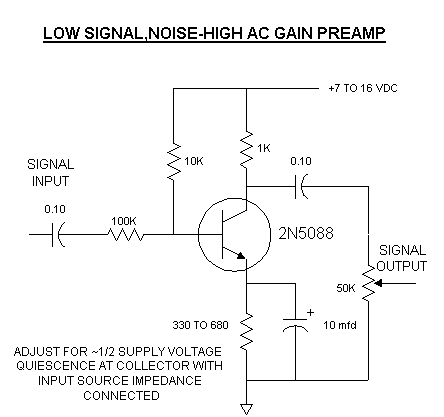microphone audio preamp for all occasions
Page © 2003-2016 by Harold Melton, KV5R. All Rights Reserved. Rev. Jan. 2016, minor edits for clarification. Text and schematic by Anthony Gargasz, KB8WOW.
This nifty little audio preamp can be used for just about anything you can dream up, from microphones, QRP rigs, even guitars.
An emitter resistor value of 390 ohms works well in most cases.
All resistors should be 1/8 watt, 5% tolerance. Regular carbon composition types are OK. Use metal film types if you require ultra-low noise operation.
[The DC bias-blocking caps are 0.1μF -ed.]
The emitter bypass capacitor can be eliminated for low source impedance devices such as dynamic microphones and guitar pickups. High impedance devices such as crystal and electric condenser mics will require the capacitor. Although a 10 mfd. electrolytic is a good starting value, you may use up to 100 mfd. to get maximum AC gain. Be judicious, however, too much gain in a single stage invites hum and oscillation instabilities. The capacitor should have a 35 VDC rating.
Want to experiment with the frequency response? For low impedance sources try reducing the value of the input capacitor (not past [less than] 0.01 [μF]) for more treble. Increasing the output capacitor (up to 4.7 mfd.) will boost the bass. There is allot [a lot] of gain interaction when you change the capacitor values, so be prepared for some trade-offs.
Construction is not critical, perf board works great. There is only one rule-of-thumb, keep all component leads that attach to the transistor as short as possible.


Are the two base resistors swapped (100k where the 10k should be)?
I dont think you can fix the bias by changing Re emitter resistor. Rb must be around 1Meg, or the Vce voltage is going to be too small and there wont be any gain nor any excursion room.
Here’s what I used: Rb 1.5Meg, Re 220, Rc 1k. 2n5088.
Vc 6.4v V3 1.4v, beta around 1400.
I also tried an 2n3904 at Beta 300 with Rb of 680k
Would it be worth changing the input and output capacitors to 4.7uF to get better basse response?
Heil recommends 1uf non polarized tantalum cap to isolate and couple a dynamic element.
Would it be worth changing the input and output caps to 4.7uF to get better basse response?
Hello,
“Use metal film types if you require ultra-low noise operation.”
What do you mean by this statement? Noise does not depend on the composition of the resistor (only on its temperature), so I’m a bit confused.
Thanks in advance.
Please see this article. Apparently, thermal noise does not depend on the composition of the resistor, but current noise does.
Thanks for this. I am looking to hook up my rigs to a studio mic and mixer. The W2IHY Iplus looks like a simple way to do it. But it’s more than I wish to spend. With this circuit I should be able to build a box similar to the Iplus.
73 Jennifer KK6FVP
?? Your mixer should take your mic input. You only have to attenuate your mixer’s output to your radio’s input. You don’t need a preamp for that.
What value are the .10 capacitors? 100uF? pF?
apologies, as I’m new to electronics.
They are 0.1 μF (aka mfd, microFarad), which is a common value used in audio circuits. Their purpose there is to block the DC biases but pass the audio, else you’d have DC on the input and output (and fry something).
A 100μF would be a medium-sized electrolytic, like a small power supply filter, and a 100pF would be for radio-frequency circuits.
I think there’s a tradition where if not shown, it’s assumed to be μF.
Thanks for the reply. As I’m just starting out this is very helpful.
Thank You for pointing out that the article needed some clarification! I’ve updated it in a couple places.
73, –kv5r